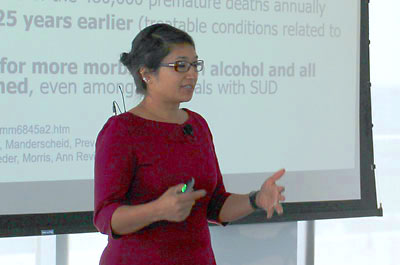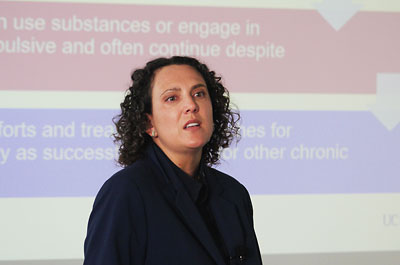Medications, Open Communication Vital to Treating Substance Use Disorders
Abstract
Dialogue begins with asking patients about their substance use, said experts at APA’s first meeting of the @theAPA Educational Series.
Medications are crucial and effective tools for treating patients with substance use disorders (SUDs), but communication and rapport between psychiatrist and patient are just as important, experts in addiction psychiatry told attendees of APA’s first meeting of @theAPA Educational Series, “Addictions Update,” in July.

Psychiatrists have a lot of impact on patients just by asking about something, even if the conversation does not get to the point where treatment begins, said Smita Das, M.D., Ph.D., M.P.H.
Smita Das, M.D., Ph.D., M.P.H., chair of APA’s Council on Addiction, began with a discussion about smoking cessation.
“The principles of addiction are going to help us understand how to not only treat [tobacco use disorder] with medications but also how to talk to our patients and give them hope about tobacco cessation,” Das said.
Nicotine is a highly addictive drug that has a range of pharmacological effects, including activation of the dopamine reward pathway in the brain, she noted, and patients will experience withdrawal symptoms when they stop using tobacco. However, as with other SUDs, tobacco use disorder also has behavioral and psychosocial components, she added.
Das stressed the importance of asking patients about tobacco use at every visit.
“We have a lot of impact on our patients just by asking about something, even if we don’t get to the point of treating them,” she said, adding that it is important not to be too aggressive. “We don’t want to necessarily push them into doing something they don’t want to hear about … it’s more that we’re saying, ‘I’m taking the time out to talk about this, so it’s important.’”
Das outlined a five-point method for helping patients quit using tobacco, the “5 As”:
Ask about tobacco use.
Advise the patient to quit.
Assess the patient’s readiness to try to quit.
Assist the patient with attempting to quit.
Arrange follow-up care.
Das rounded out her presentation with a discussion of the pharmacologic treatments approved by the U.S. Food and Drug Administration (FDA) for use in smoking cessation: transdermal nicotine patches, nicotine gums and lozenges, nicotine inhalers, nicotine nasal sprays, bupropion SR, and varenicline.
Das also discussed pharmacologic treatment for alcohol use disorder (AUD). She noted that 10% of Americans have AUD, and of those, only 7% receive treatment. Furthermore, 21% of people aged 12 years or older have reported binge drinking (drinking more than five drinks on one occasion) in the previous month, and nearly 6% report binge drinking more than five days in the previous month, she said.
Again, the key is to open the conversation simply by asking about use, Das said.
“It’s important for us to ask about alcohol use because there is a strong likelihood that many of our patients are at risk of an alcohol use disorder,” Das said. “One thing that I like to do with patients is to talk about what a standard drink is because there are a lot of misconceptions about that.”
Das noted that mental illness and substance use often coincide. She offered four steps for integrating screening and treatment for AUD into general mental health treatment, as follows:
Use a validated scale in regular practice.
Ask about the patient’s current drinking level and clarify what constitutes a drink.
Assess the patient’s motivation for changing alcohol use if their drinking patterns indicate a high risk for AUD.
Follow up on harm reduction efforts, therapy options, and medication treatment.
Das concluded her talk with a discussion of medication approaches to AUD. Three medications are currently FDA-approved for use in treating AUD: naltrexone, acamprosate, and disulfiram. Das added that some federal guidelines for treating AUD, such as those used by the U.S. Department of Veterans Affairs, include gabapentin and topiramate.

Detoxification is not an effective treatment, and psychiatrists must ensure that patients have access to continued care that includes medication for SUD, said Carla Marienfeld, M.D.
Carla Marienfeld, M.D., health sciences clinical professor of psychiatry at the University of California, San Diego, discussed medication treatment of OUD. She described three waves in the rise of opioid overdose deaths, noting that the first wave started in 1999 with the rise of prescription opioid overdose deaths. The second wave started in 2010 with a rise in heroin overdose deaths, and the third wave started in 2013 with a rise in synthetic opioid overdose deaths.
“Right now we’re really in a fourth wave, which is a rise in overdose deaths involving combinations of opioids,” Marienfeld said.
She described how the demographics of opioid use and overdose have changed in recent years.
“There are long histories of underrepresented minorities in inner cities being disproportionately affected by opioid use, a lack of treatment or access to health care, and poverty. [Then we saw] more Whites of slightly higher socioeconomic status being affected,” Marienfeld said. “However, in the past three to four years in particular we’re seeing a shift where more and more underrepresented minorities are being disproportionately impacted by overdose deaths. It’s important to bear that in mind when we’re thinking about screening, interventions, and public health.”
Marienfeld stressed the importance of looking beyond a patient’s immediate detoxification and ensuring that the patient has access to continued care that includes medications for OUD such as buprenorphine, methadone, and naltrexone.
“Detox alone is really not an effective treatment. Whether we’re talking about alcohol or opioids or any other substance, stopping the substance really is not treatment. It’s only what’s getting the patient to a place where they can start participating in treatment,” Marienfeld said.
She added that abstinence-only treatment is not all that effective as a long-term strategy.
“Think about what we’re asking of [people with OUD]. We’re asking them to exert an athletic level of discipline and sustained determination, without much training or experience in behavioral self-control, to fully counter their neurobiological drives,” she said.
Therefore, medications for OUD are critical for lowering the risk of relapse and consequent overdose death, Marienfeld said. She cited a study that was published in Addiction in February 2020 that compared overdose mortality among patients in specialty care settings who took medication for OUD with that of patients who did not take medications for OUD.
“Compared with nonmedication treatment, those on medications for OUD had an 80% lower [risk] of overdose death during care,” Marienfeld said.
However, she noted that relapse rates among people who do not take medications for OUD are as high as 80%, thus highlighting the need for ongoing treatment.
“This brings us to the conversation where we say [to the patient] ‘you may need this medication for life,’” Marienfeld said. ■
The next @theAPA event will take place on Friday, November 17, in Washington, D.C. Experts in child and adolescent psychiatry will present on autism spectrum disorders, ADHD, anxiety disorders, mood disorders, and gender dysphoria. Learn More.



